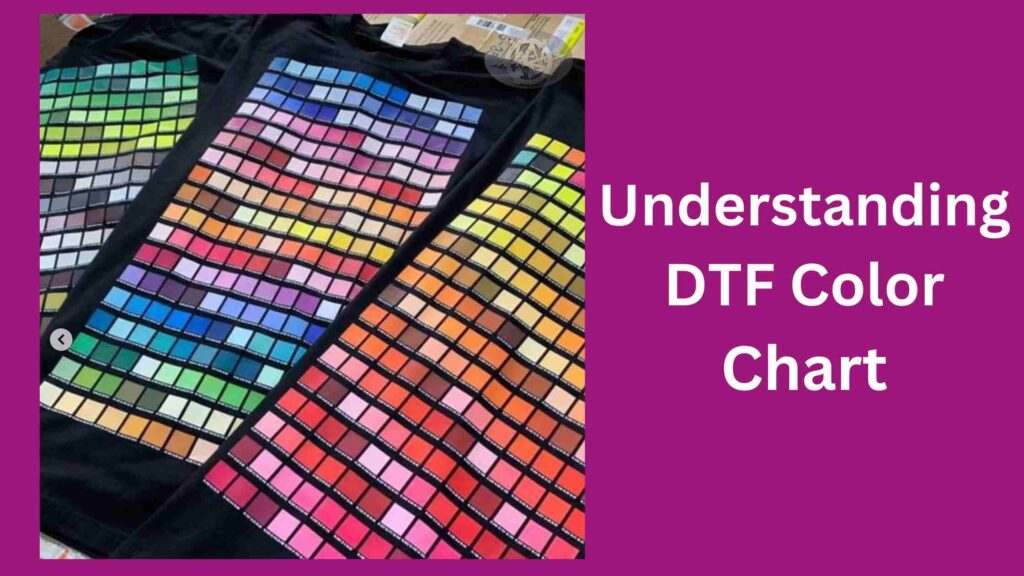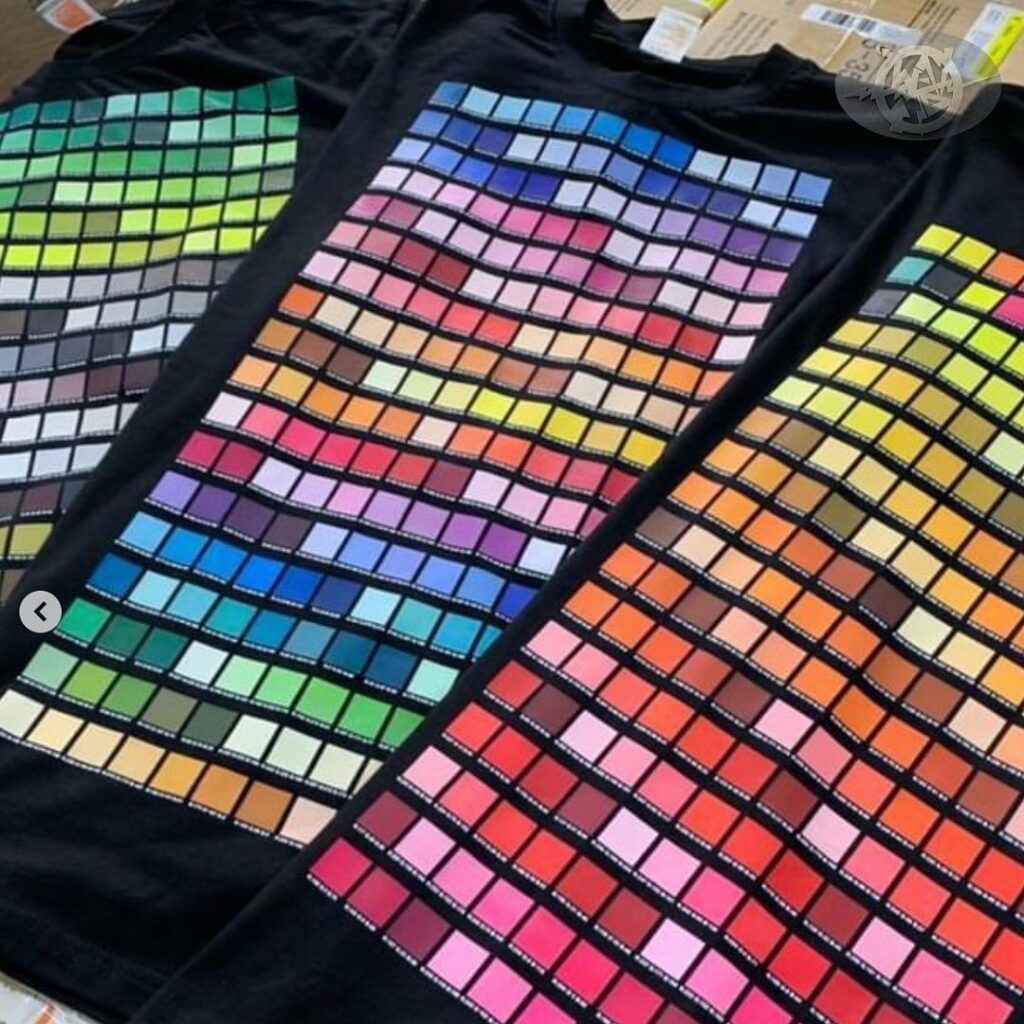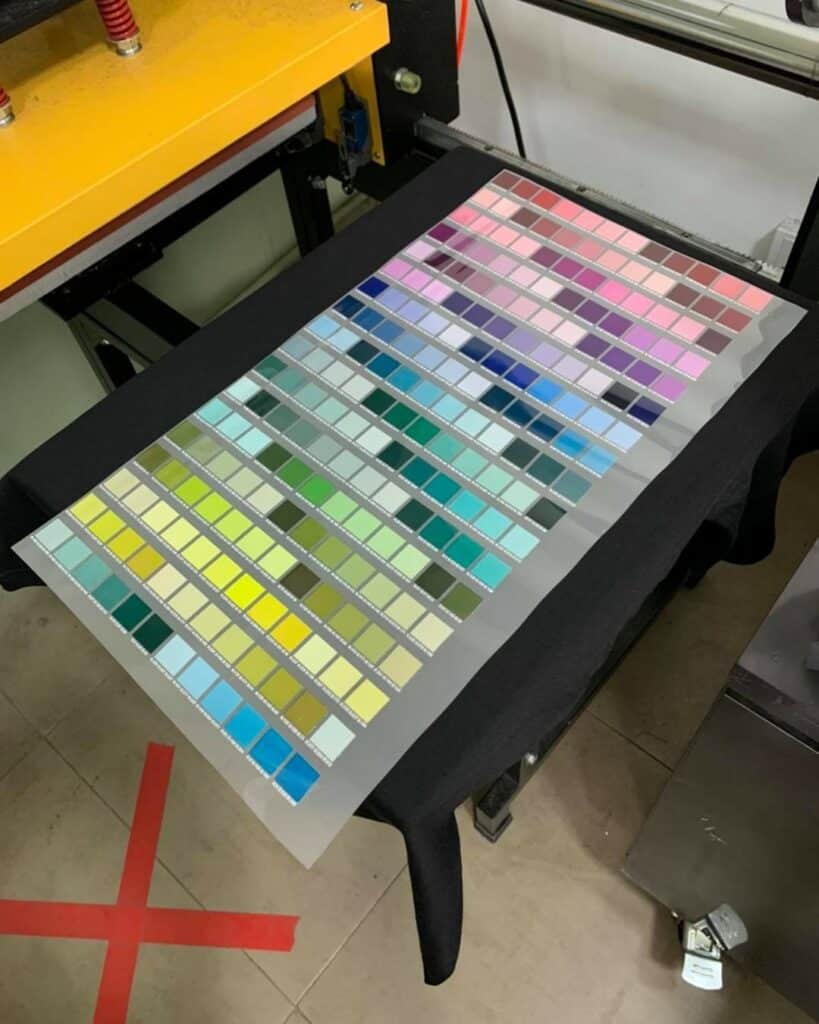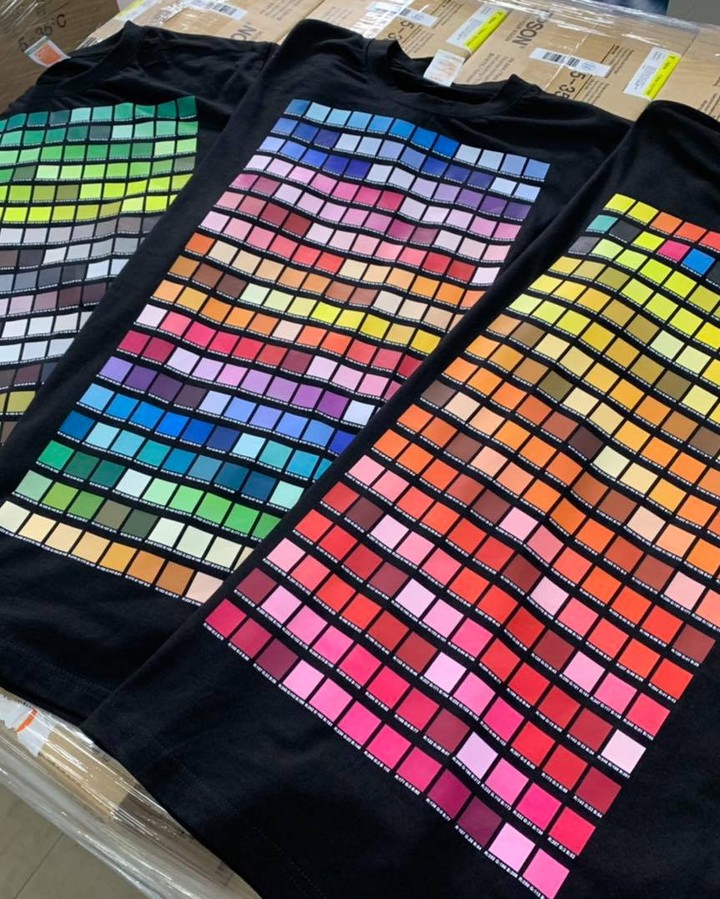Are you a DTF printing fan that wants to learn more? In such case, you are at the correct spot. Color fidelity is crucial in the world of DTF printing. The DTF color chart is a crucial tool for every printing project. It was created to help in producing accurate and rich color reproduction. In this article, we will explore the significance of the DTF color chart. We will see its role in the printing process, and provide valuable insights on how to effectively use it. At the end, we will give you the link of DTF color chart download (PDF).

Understanding DTF Color Chart
It’s important to have a thorough knowledge of the DTF printing process and the role that color charts play within it in order to fully appreciate the significance and effectiveness of the DTF color chart. Let’s explore this area in more detail.
A Summary of the DTF Printing Process
Modern printing methods include DTF (Direct-to-Film) printing involve transferring ink from a specific film straight onto a variety of substrates including textiles, ceramics, or metal surfaces. It is a well-liked option for customized goods, promotional things, and custom garments. DTF technology is famous for its adaptability, toughness, and rich color reproduction.
Color charts’ function in DTF printing
The ability to print with accurate colors is essential. The DTF color chart serves as a reference manual for precise color selection and matching throughout the printing process. It offers a graphic depiction of the numerous color swatches, their associated codes and names, and the various densities possible with DTF printing.
Advantages
- Precise Color Reproduction: The DTF color chart enables printers to achieve consistent and accurate color matching. It ensures the desired outcome for each print job.
- Saving time and money: By using the DTF color chart, printers can choose colors without trial and error. This results in wasting less material and speeding up production.
- Improved Customer Satisfaction: Meeting customers’ expectations leads to repeat business and a good reputation for the printer.
The key to getting great color accuracy and consistency in DTF printing is understanding the DTF color chart. In the following part, we’ll examine the DTF color chart’s components.
Components of DTF Color Chart

The DTF color chart is made up of a few important parts that work together to give a complete guide for choosing and matching colors in DTF printing. To use the color chart properly, you have to understand these elements. Let’s examine them carefully:
- Color Swatches: There are several different color swatches in the DTF color chart, each of which represents a different color. These swatches are often presented in an orderly and systematic way. This makes it simple to identify and choose colors for printing. The intended color is represented visually by each color swatch.
- Color Codes and Names: The DTF color chart includes appropriate color codes and names next to each color swatch. By entering these codes into their printing software or equipment, printers can precisely reproduce colors using formats like RGB (Red, Green, Blue) or CMYK (Cyan, Magenta, Yellow, Black). Designers, printers, and clients can more effectively communicate using color names.
- Color Density Levels: The DTF color chart can additionally display several color density levels in addition to hue. This refers to the intensity or saturation of a particular color. Printers can produce minor differences in color look by using various density levels. It gives them greater creative flexibility and customizing options.
- The DTF color chart is a complete visual and informative resource for printers. It combines color swatches, codes, names, and densities. They can choose and reproduce colors exactly, resulting in results that are accurate and consistent across several print jobs.
In the next section, we’ll talk about how to use the DTF color chart and its parts to get the best color matches when DTF printing.
How to Use DTF Color Chart
The DTF color chart is a powerful tool that can significantly enhance color accuracy in DTF printing. To maximize this resource, you must know how to utilize it. Here are some key steps to follow:
Selecting the Right Color Swatch
- Decide on the ideal shade: Choose the particular color you want your print job to look like.
- Find the relevant color sample by: To discover a color swatch that closely resembles the one you want, search the DTF color chart.
Combining Colors to Get the Results You Want
- Color codes that can be compared: Once you found the color swatch, write down the color codes that go with it (such as RGB or CMYK).
- Input color codes: For correct color reproduction, enter the color codes into your printing software or equipment.

Color Mixing and Customization:
- Experiment with color density levels: The DTF color chart can contain various density levels for each color swatch. Test different levels to achieve the desired intensity or saturation of the color.
- Color mixing: If you aim to create custom colors, the DTF color chart can serve as a starting point. By mixing various inks or modifying density levels, you may mix and create new colours using the current colors as a guide.
- You can use the DTF color chart to obtain accurate color matching and replicate the required colors in your DTF prints by following these instructions. It’s crucial to remember that printer, ink, and environmental variables might affect color fidelity.
In the next part, we’ll talk about how important it is for the DTF color chart to be accurate and how that affects customer happiness and good printing results.
Importance of Accuracy in DTF color chart
In DTF printing, accurate color reproduction is essential since it has a direct influence on the success and overall quality of the prints. Here are some reasons why it is necessary to use the DTF color chart to ensure color accuracy:
Consistency in Color Reproduction:
- Branding and identity: It’s crucial for companies and brands to maintain consistent color schemes throughout various print projects. The DTF color chart allows printers to precisely reproduce colors, assuring branding and visual identity consistency.
- Repeat Orders: A consumer can ask for a repeat order if they were happy with a prior print job. Printers might accurately recreate the colors from the original print by following the DTF color chart, fostering client loyalty and confidence.
Replicating brands and their logos:
- Color representation: A lot of companies have distinctive brand colors and logos that must be accurately replicated. The accuracy of the brand’s visual depiction is ensured by the DTF color chart, which enables printers to accurately match these hues.
- Expectations from the client: For printed goods, clients often have precise color preferences. Printers can meet and surpass these demands by using the DTF color chart, which will lead to customer satisfaction and faith in the printing business.
Obtaining Client Satisfaction:
- Accurate Color Representation: When it comes to the color fidelity of their prints, customers have specific expectations. Customers will be more satisfied if printers use the DTF color chart to generate outputs that closely match the specified colors.
- Avoiding Color Discrepancies: Customers can feel disappointed and unsatisfied as a result of inaccurate color replication. The DTF color chart assists printers in preventing color errors and guarantees that the finished prints meet or surpass client expectations.
- The DTF color chart must be accurate to satisfy customers, build a respectable printing business, and fulfill print job color standards.
Common Challenges with DTF Color Chart
Even though the DTF color chart is a crucial tool for obtaining color accuracy in DTF printing, certain difficulties could still occur. It is crucial to be aware of these difficulties and to understand how to deal with them. Here are some typical problems with the DTF color chart and recommendations for fixing them:
Color Difference Caused by Various Printers or Inks:
- Make sure your printer is calibrated correctly in order to accurately represent the colors shown in the DTF color chart. For calibration instructions, see the manufacturer or the handbook for your printer.
- Use premium, suitable inks that have been specially designed for DTF printing. If the ink isn’t good or isn’t the right color, the colors won’t match and the copy won’t be correct.
Environmental Factors Impacting Color Accuracy:
- Lighting Conditions: The lighting in your printing environment can affect color perception. Utilize uniform, neutral illumination that closely resembles the viewing conditions under which the final prints will be viewed.
- Extremes in temperature and humidity can impact the way ink behaves and the precision of the colors it produces. Keep the temperature and humidity levels within the suggested limits to maintain a stable printing environment.
Troubleshooting Color Issues:
Before committing to a complete print run, do routine color sample tests using the DTF color chart to assure proper color reproduction.
- Color Adjustment: To correct color output if there are any differences, use the color adjustment tools in your printing program or hardware. The DTF color chart should be used as a guide for making modifications.
- Always keep in mind that obtaining perfect color fidelity in every print job can prove difficult for a variety of reasons. However, you can minimize color difficulties and enhance the overall consistency of your DTF prints by being proactive and putting troubleshooting tactics into practice.
In the following part, we’ll provide advice for using the DTF color chart to optimize its advantages and assure correct color reproduction in your printing jobs.
Tips for Effective Usage of DTF Color Chart

Consider the following advice to get the most out of the DTF color chart and ensure correct color reproduction in your printing projects:
Consistent color chart Updates:
- Keep Up to Date: Keep note of any DTF color chart changes or upgrades. New versions with increased color gamuts or greater color accuracy might be released by manufacturers.
- Swap Out Old Charts: Color charts’ accuracy can decrease over time due to fading or use. To preserve accurate color references, replace them on a regular basis.
Handling and Storing color charts Correctly:
- Avoid direct sunlight by keeping the DTF color chart in a cool, dark location. Long-term exposure to sunlight may distort or fade colors.
- Keep Contamination at Bay: Keep the color chart clear and uncontaminated by anything that could tamper with its hues, such as ink or chemicals.
- Use clean hands while handling the chart to prevent the spread of oils or dirt.
Documenting Color Mixing Ratios and Formulas
- Keep Track of Color formulae: If you’re combining several inks to create customized colors, keep track of the exact ratios and formulae you used. You can duplicate the same colors in subsequent print runs using this guide.
- Label Custom Colors: Give any new custom colors you make special names or codes. When replicating those hues, the labeling scheme ensures consistency and simplicity of reference.
- You can make the most of the DTF color chart and ensure correct color reproduction throughout your printing jobs by paying attention to these pointers.
DTF Color Chart Download Link
Conclusion
For proper color reproduction in DTF printing, the DTF color chart is an essential tool. Printers can accomplish consistent and accurate color matching by knowing its components, using it well, and resolving typical issues.
While difficulties could occur as a result of variances in the printer or environmental conditions, careful troubleshooting can fix these problems. As the printing business evolves, DTF color charts and digital technologies will improve color reproduction.
FAQs
Accurate color reproduction requires the use of the DTF Color Chart. It acts as a reference tool that enables printers to accurately choose and match colors, maintaining consistency and upholding customer expectations.
It is recommended to use industry-standard DTF Color Charts that are widely recognized for their color accuracy. However, custom color charts can also be created to align with specific branding or color requirements.
To ensure color accuracy, it is essential to calibrate your printer, use high-quality inks, maintain appropriate environmental conditions, and conduct regular color tests and adjustments based on the DTF Color Chart.
Consider factors including printer calibration, ink quality, lighting, and temperature/humidity levels if you see color disparities. Adjust color settings, do color tests, and seek advice from the DTF Color Chart when troubleshooting.
The printing industry is constantly evolving, and future developments may include improved color accuracy, expanded color ranges, and integration with digital tools for enhanced color matching and customization in DTF printing. Stay updated with the latest advancements in the field to make the most of DTF color charts.

Ashley Wang is a skilled sales manager with knowledge in DTF printing. She presently works for ShenLan Digital, a reputable DTF printer maker. Ashley is the best person to offer advice on selecting the most suitable DTF printer because she has tested a lot of them. She launched DTFPrinterSchool to educate individuals and organizations about DTF printing technology, providing her expertise and observations on the most recent advancements in the sector. Ashley is an invaluable resource for businesses and individuals wishing to invest in DTF printing technology because of her expertise and experience in the industry.
